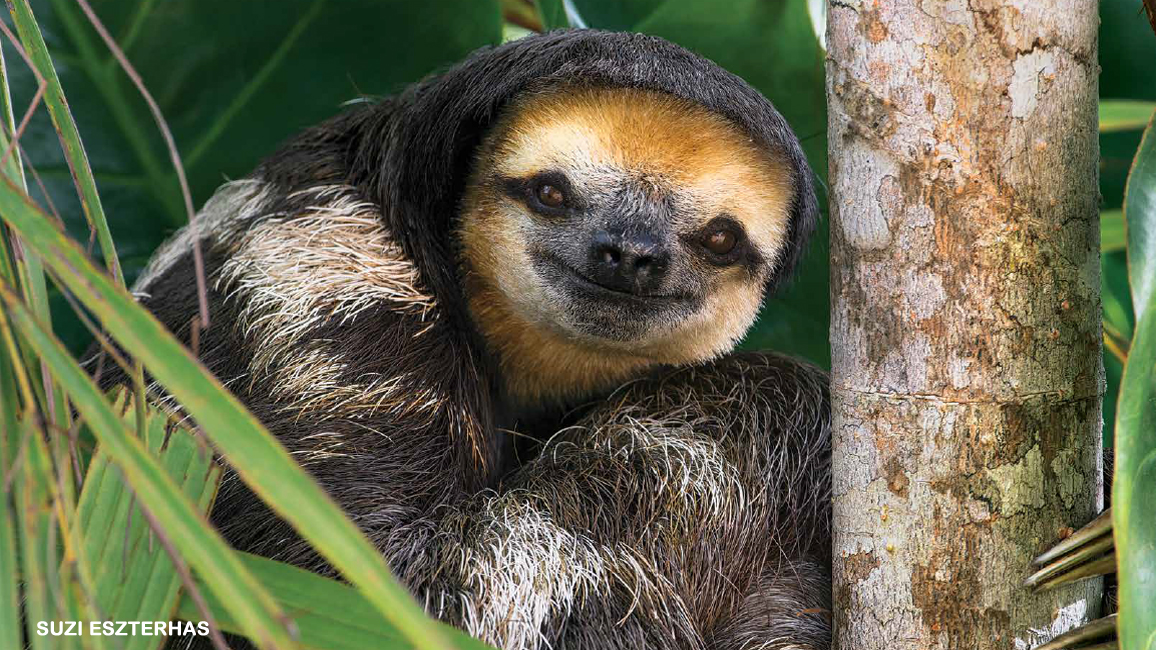
Smile—It’s a Sloth!
By Simon Sloth, as told to Hannah Schardt; Photos by Suzi EszterhasHey, there! I’m Simon Sloth. Climb up into this tree for a sloth’s-eye view of my island home. This place is just right for—and even named for—my friends and me. No wonder I’m smiling!

Welcome to Sloth Island! It’s a small island in the middle of a big river in Guyana, a county in South America (see map above).
All the sloths in this story—and on Sloth Island—are pale-throated sloths. There are six species of sloths altogether, and all of us live in tropical rainforests in Central and South America. My pale-throated friends and I are some of the least-known sloths around. If you’d like to get to know us better, keep reading and hang out for a while!

SLOW IS BEST
Did you know that another word for “lazy” is “slothful”? Now, it’s true that sloths are slow. It can take me a whole minute to climb six feet up a tree. And I’m even slower on the ground. But we aren’t lazy—not really. It’s just that a slow-and-steady life works for us.
Sloths use energy very, very slowly. That means we don’t need to eat too much, so we don’t need to spend too much time searching for food. We can just settle into a comfortable spot at the top of a tree and munch the leaves within reach.
Sometimes our slowness keeps us safe. When predators such as jaguars and eagles scan the scenery, they are looking for movement: rustling leaves or a blur on the forest floor. When you’re so slow that you’re barely moving, even sharp-eyed predators have trouble spotting you!
BUILT TO HANG
Sloth limbs are long, but they aren’t made for walking or running. Tipped with sturdy, curved claws, they help us “hang out” for hours at a time. In fact, we hang on so tightly that we may sleep that way. Some sloths have even been known to keep hanging on for a while after they die! (I try not to think about that.)
Our long, flexible necks help us reach leaves to eat without moving our bodies much. And when rain falls—which it often does in the rainforest—our long, coarse outer hairs keep the water away from our skin. Those hairs also have grooves on them where green, plant-like algae (AL-jee) grow. That may sound a little gross to you. But it helps us blend in with the leaves around us.

SCOOP ON POOP
Even our digestion is slow. The leaves we eat take a long time to move through our guts. So we poop only about once a week. When it’s finally time to poop, we don’t do it from up high. We climb down the trees and poop right on the ground!
SLEEPY SLOTHS
You’ve probably heard that sloths sleep a lot. In fact, people who watched sloths only in captivity thought we slept 19 hours a day! A few years ago, scientists put special trackers on wild sloths to find out how they spend their time. They found that wild sloths sleep only about nine hours a day. That leaves plenty of time for living a full life in the trees . . . slooowly.
MEET THE SLOTHS
There are two different families of sloths: two-toed and three-toed. Those names are a little misleading: All sloths have three “toes” on each of their back limbs. But three-toed sloths also have three claws on the “fingers” of each front limb. Two-toed sloths have only two.
See if you can spot some differences in the six species of sloths above. Look closely at each sloth’s size, color, and face shape. And don’t forget to count their claws!
















